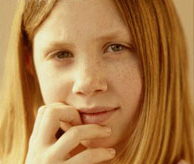| ASA: Treatment | |
| ASA: Learning Approaches | |
| Jeff, Age 35 | |
| Richard, Age 52 | |
| NIMH: Autism Spectrum Disorders (pdf) | |
| AAP - Medical Home & Early Intervention (pdf) | |

Learning Approaches - Complementary Approaches
While early educational intervention is key to improving the lives of individuals with ASD, some parents and professionals believe that other treatment approaches may play an important role in improving communications skills and reducing associated behavioral symptoms. These complementary therapies may include music, art or animal therapy and may be done on an individual basis or integrated into an educational program. All of them can help by increasing communication skills, developing social interaction, and providing a sense of accomplishment. They can provide a non-threatening way for a child on the autism spectrum to develop a positive relationship with a therapist in a safe environment.
Art and music are particularly useful in sensory integration, providing tactile, visual and auditory stimulation. Music therapy is good for speech development and language comprehension. Songs can be used to teach language and increase the ability to put words together. Art therapy can provide a nonverbal, symbolic way for the child to express him or herself.
Animal therapy may include horseback riding or swimming with dolphins. Therapeutic riding programs provide both physical and emotional benefits, improving coordination and motor development, while creating a sense of well-being and increasing self-confidence. Dolphin therapy was first used in the 1970s by psychologist David Nathanson. He believed that interactions with dolphins would increase a child's attention, enhancing cognitive processes. In a number of studies, he found that children with disabilities learned faster and retained information longer when they were with dolphins, compared to children who learned in a classroom setting.
Again, as with all other therapy or treatment approaches, it is important to gather information and make an informed decision. Keep in mind however, with most complementary approaches, there will be little scientific research that has been conducted to support the particular therapy.



